Hitachi Deskstar 7K1000 in RAID 0: Is Two Terabytes really better than One?
by Gary Key on April 19, 2007 12:15 AM EST- Posted in
- Storage
iPeak Business Application Tests
Our iPeak Winstone benchmarks offer a glimpse into how well our hard disk drives will handle general office applications, media encoding, and graphics manipulation. While the business applications that are being tested tend to be more CPU bound at times, the performance of the hard drive can and will make a difference in the more disk intensive video and graphics applications where large media files are typically being edited.
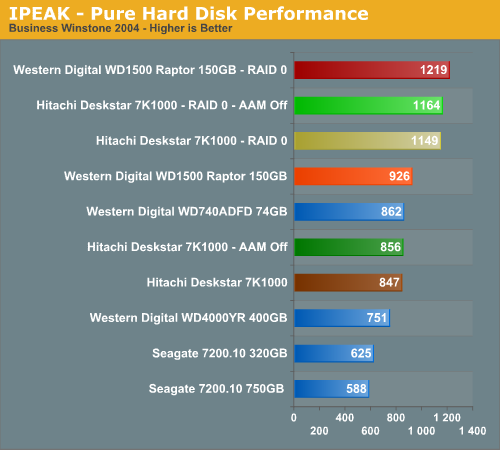
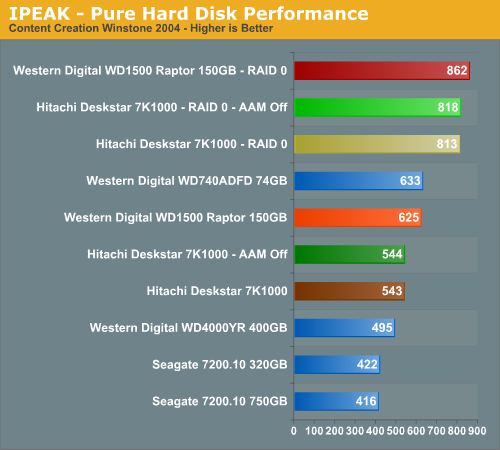
As expected the WD1500 Raptor drives finish at the top in our business application tests as its 10k RPM spindle speed and optimized cache play an important role in its ability to sustain high transfer rates, especially in the Content Creation benchmark where transfer block sizes are significantly larger and more random than in the Business application benchmark. This is true with either a single drive or RAID 0 setup although we see the 7K1000 trailing the WD1500 by less the 5% in these tests. While RAID 0 has the theoretical capability to improve throughput by up to 100% before system overhead, we only see a 31% to 35% improvements in these pure hard disk benchmarks.
iPeak General Task Tests
The iPeak based General Task benchmarks are designed to replicate utility based application tasks that typically are disk intensive and represent common programs utilized on the majority of personal computers. While the WinRAR program is very CPU intensive it will typically stress the storage system in short bursts. Our antivirus benchmark will stress the storage system with continual reads and sporadic write requests while the defragmentation process is split between continual read and write requests.
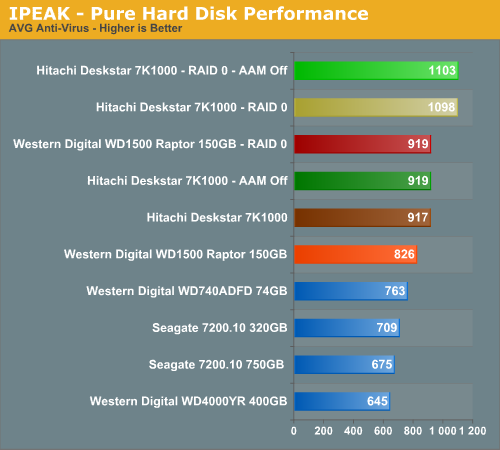
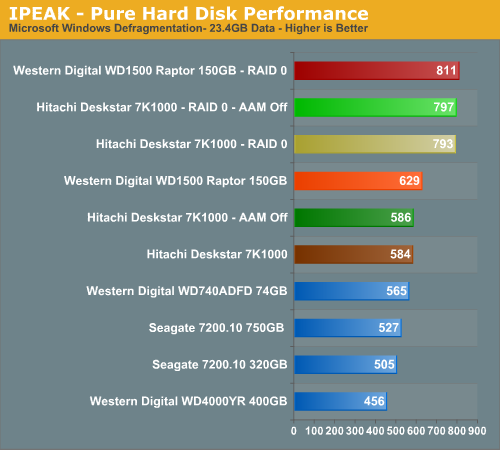
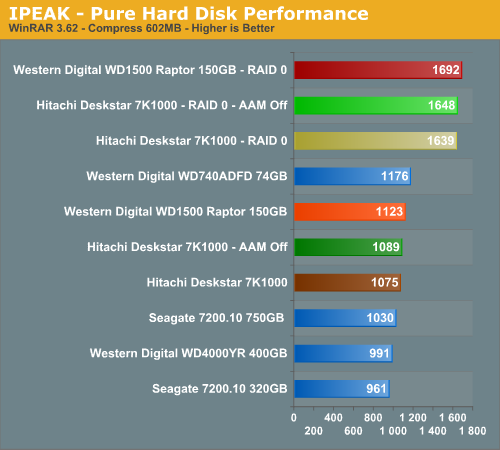
The 7K1000 performs extremely well in the Anti-Virus and Defragmentation test where its 32 MB cache benefits read operations with results that mirror the PCMark 2005 tests. This holds true with the RAID 0 configuration although we only see a 20% improvement in the AVG test results. Also of interest is that in the AVG test we see the Raptor RAID 0 setup score the same as the single drive 7K1000 configuration.
The Raptor holds a small advantage in the Windows defragmentation test in both the RAID 0 and single drive results. The rotational speed of the Raptors just cannot be beat in this test, but the 7K1000s score extremely well due to their cache size.
This is especially true in the WinRAR tests where the rotational and access speeds of the Raptors outperformed the 7K1000 setups in both configurations. In this test, write speeds are very important and we see the RAID 0 setups scoring around 50% better, though we expected better performance based upon the PCMark05 results. However, keep these pure performance results in mind as they will not be repeated in our actual WinRAR tests.
Our iPeak Winstone benchmarks offer a glimpse into how well our hard disk drives will handle general office applications, media encoding, and graphics manipulation. While the business applications that are being tested tend to be more CPU bound at times, the performance of the hard drive can and will make a difference in the more disk intensive video and graphics applications where large media files are typically being edited.


As expected the WD1500 Raptor drives finish at the top in our business application tests as its 10k RPM spindle speed and optimized cache play an important role in its ability to sustain high transfer rates, especially in the Content Creation benchmark where transfer block sizes are significantly larger and more random than in the Business application benchmark. This is true with either a single drive or RAID 0 setup although we see the 7K1000 trailing the WD1500 by less the 5% in these tests. While RAID 0 has the theoretical capability to improve throughput by up to 100% before system overhead, we only see a 31% to 35% improvements in these pure hard disk benchmarks.
iPeak General Task Tests
The iPeak based General Task benchmarks are designed to replicate utility based application tasks that typically are disk intensive and represent common programs utilized on the majority of personal computers. While the WinRAR program is very CPU intensive it will typically stress the storage system in short bursts. Our antivirus benchmark will stress the storage system with continual reads and sporadic write requests while the defragmentation process is split between continual read and write requests.



The 7K1000 performs extremely well in the Anti-Virus and Defragmentation test where its 32 MB cache benefits read operations with results that mirror the PCMark 2005 tests. This holds true with the RAID 0 configuration although we only see a 20% improvement in the AVG test results. Also of interest is that in the AVG test we see the Raptor RAID 0 setup score the same as the single drive 7K1000 configuration.
The Raptor holds a small advantage in the Windows defragmentation test in both the RAID 0 and single drive results. The rotational speed of the Raptors just cannot be beat in this test, but the 7K1000s score extremely well due to their cache size.
This is especially true in the WinRAR tests where the rotational and access speeds of the Raptors outperformed the 7K1000 setups in both configurations. In this test, write speeds are very important and we see the RAID 0 setups scoring around 50% better, though we expected better performance based upon the PCMark05 results. However, keep these pure performance results in mind as they will not be repeated in our actual WinRAR tests.










48 Comments
View All Comments
userexists - Thursday, April 19, 2007 - link
As I understand it, from previous articles, the limiting factor in gaming tests seems to be the CPU. I understand why you'd want to use an Opteron or Xeon system for benchmarking the access patterns -- the only people who care about those results are probably going to be running servers. But most people playing games aren't using server components. I'd love to see how the QX6800, for example, and some fast RAM affects gaming benchmarks under RAID-0 -- i.e. answer the question of whether the CPU bottleneck has been relieved. Probably not, but who knows until you test it, right?Gary Key - Sunday, April 22, 2007 - link
I will have some Intel benchmarks with a QX6700 up this week although I doubt the results will be that surprising. ;-)cbuchach - Thursday, April 19, 2007 - link
For all the arguing, NO ONE can say that RAID0 is overall slower. In most situations it is faster by varying degrees, maybe a percent or two or maybe more. For enthusiasts, the percent counts. Look at heatsinks or overclocking. Someone may spend an extra $50 for a better heatsink, for what, maybe an increased overlcock from 3300 MHz to 3400 MHz or spend lots of cash for a water cooling setup, or spend an extra $100 for slightly better RAM; the list goes on and on. For real enthusiasts, the extra 1-2% counts.(And as far as data loss goes, everyone should backing up all their nonrecoverable data data anyways, so that point is moot.)
tshen83 - Thursday, April 19, 2007 - link
and don't even talk about performance, people who want performance will buy Raptors X or SCSI drives. this drive is for storage. RAID storage for cheaptshen83 - Thursday, April 19, 2007 - link
yes, backing up 2TB of data, with what? probably a RAID1(takes 4 drives to have 2TB) or RAID5(3 drives) of the same drives. so why not just use RAID1 or RAID5 in the beginning?ncage - Thursday, April 19, 2007 - link
I just wish hitachi would make this drive in something other than 1TB. I love hitachi hard drives and just which this awesome thing would come in like a 500GB or something like that.Ncage
Gary Key - Thursday, April 19, 2007 - link
750GB drives will be available in May, the smaller capacities later this summer.TomWomack - Thursday, April 19, 2007 - link
What I'd be much more interested by is a review of performance for a pair of these drives in RAID1. RAID1 read speed ought to be the same as RAID0, and most disc-limited tasks are read-limited, whilst running drives in RAID1 seems a sensible reaction to the combined unreliability and cheapness of modern HDDs.[also you can break a RAID1 mirrored pair and grovel for deleted data on one of the drives while running the computer happily on the other, which I've found useful in the past]
Watson - Thursday, April 19, 2007 - link
I would love to see if useful speed increases are actually available over multiple drives when splitting OS and cache files from applications vs. Raid 0. I have a Raid 0 on 10k Raptors in my machine, and they are very fast (obviously), but I have often wondered in a reinstall if I would be better off splitting the drives and what is put on them. Any thoughts?yyrkoon - Thursday, April 19, 2007 - link
If you are wondering if booting from this array would be slower, or faster, the chances are with RAID0 if anything, the array will boot slower vs a single Raptor. The reason behind this is simple: booting windows, HDDs benifit more from faster access times, and RAID0 will increase random access times. RAID1 on the other hand, could help some here, but it really depends on the controller(RAID1 paired with the right controller can actually decrease access times, but it will not be a huge difference).Now, all that being said, there is a reason why systems, where speed, and redundancy is crucial, people opt for RAID10. Obviously, there is the redundancy factor, but you can get the from RAID5 as well as speed if enough drives are used. Pretty much, you get the best of both worlds having a RAID10 array, faster access times, and throughput. This performance of course comes at a cost, you need a minimum of 4 HDDs, so for instance, using 4x 1TB Hitachi drives, we are talking in the balpark of $1600 for a bare minimum + controller capable of handling RAID10.
When it is all said and done, unless your system is serving thousands of people data every hour of the day, heavily editing video, or some other similar task you do not need this kind of disk performance. Also, for the life of me, I can not see how making one large disk array, for your OS, and putting all your data on this array is going to help things either. Personally, I think it is much smarter, to use a single fast disk for the OS, and perhaps multiple drives for data, keeping everything seperate. As for using RAID, well, I can see an application for it, even in the home, but not for the OS.
Think about it, what is so important about the OS that you need redundancy for it ? Nothing, plain and simple. Need a RAID array for video editing, or something else ? fine, get a third HDD for the OS, and keep the RAID0 array seperate. Same goes for RAID1, or RAID5, keep it seperate from the OS, and if something catostrophic does happen, chances are, it wont be on the data disks(however, nothing is ever set in stone). I have been using this technique since the mid 90's, and have had very little problems, and have lost next to zero data, that I needed. Not only this, but it does help to organize your data, so it is more easily found later on, but not as important.
As for splitting OS/swap accross multiple drives, this is debatable. First, if all of your SATA channels are saturating what your system is capable of handeling, then no, but in theory it should help. I personally have noticed the bigest differences when transfering file locally, if I am transfering files from a PATA -> SATA drive, or vice versa. Two different interfaces, using two difference I/O channels.
</two cents>